
Of steam, flour and cookies
You know, the old "ice-cubes-in-a-hot-skillet" routine is soooo...like...last summer, isn't it? ;)
I was sitting in a sauna a couple of weeks ago, pondering nothing in particular, when this large, heavy-breathing guy shuffled down to the hot rocks, threw water on them, and climbed back up to his favourite spot. Watching the sudden burst of steam rising from the hot rocks lead from one thing to another, and I eventually picked up some small rocks on my way back home, thinking I could put them to good use for my next baking session. I put them in an old, disused bread pan, and placed them on the bottom floor of the oven.
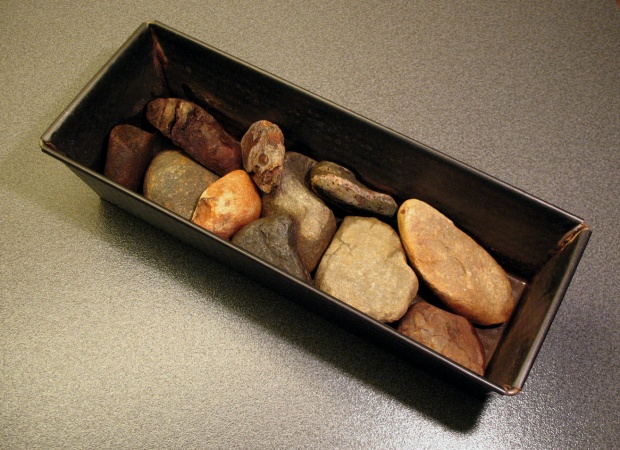
I also noticed I was running low on my bread flour (ah! The horror... the horror...), so I ran over to my grocery store, credit card in hand, ready to score more. This being the festive season and all, and many folks busy baking all kinds of butter cookies I guess, they were out of my regular flour. Well, I picked up two bags of flour from another producer and went back home. This flour has an extraction rate of 80% and an ash around .68, so it contains some more minerals than my usual flour (which is extracted at 75% and has an ash .55). This new one is probably not too far off a French T65 style flour. Both flours are pretty similar in protein content: 11.7% vs. 12%. During the first couple of feedings, I noticed a marked increase in starter activity (probably not very surprising, due to the increased mineral content), and where the starter previously ripened in 12 hrs., it now looked fit and perky after merely 8.
Earlier today I had my first test run with the rock-steaming-thing in the oven, and I baked a whole-wheat pain au levain:
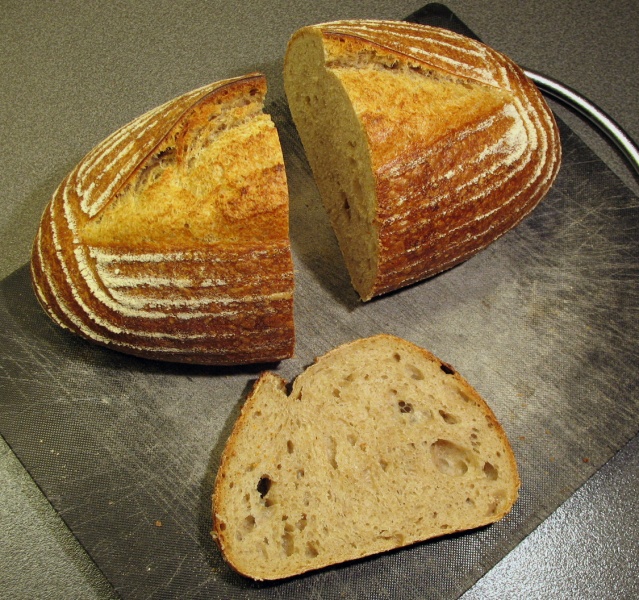
and the 5-grain levain, both from "Bread":
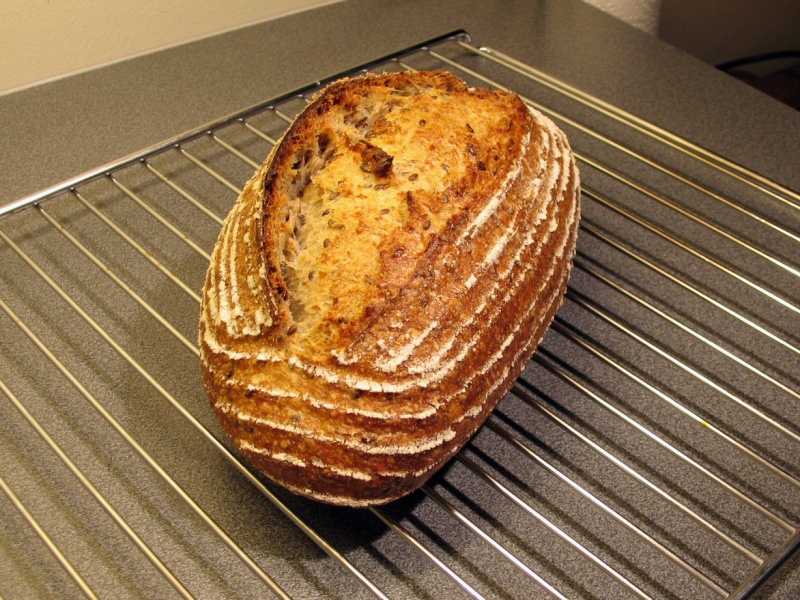
And the crumb shot:
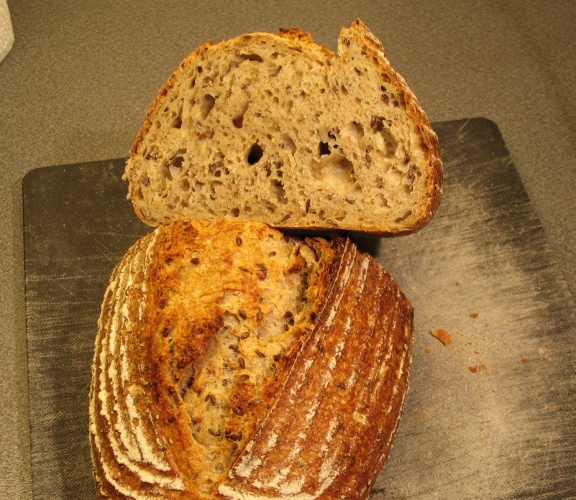
I was very happy with the outcome, and I think the new flour also lends even more taste to the breads. I guess I don't have any other option but to make the change permanent! Also, the new method of producing steam generated generous amounts of steam initially, and kept the surface of the breads moist until they were both fully expanded, roughly 15 mins. into the bake. Then I hauled the bread pan out, so the loaves could finish baking in a dry oven.
Finally, something for the coffee! I'm not much of a cookie baker, but it's that time of year, isn't it? Out with the Santa beard and the cookie recipes! Here's this years' bake:
Oat and date chews and cornmeal-raisin cookies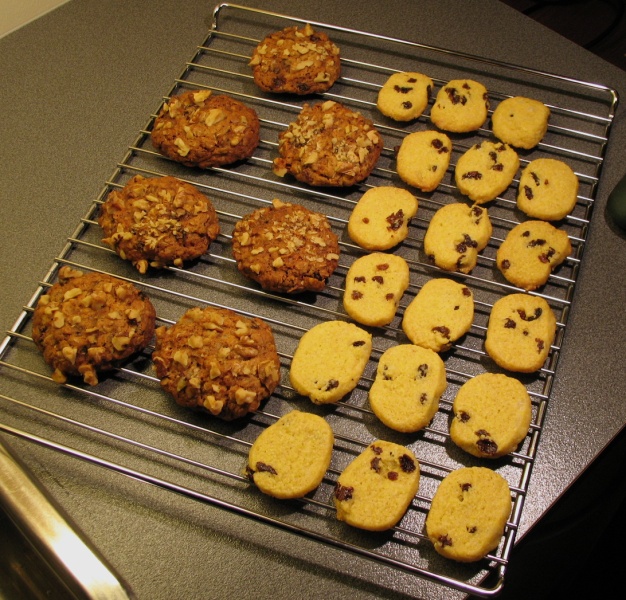
Hazelnut butter cookies and double chocolate biscotti
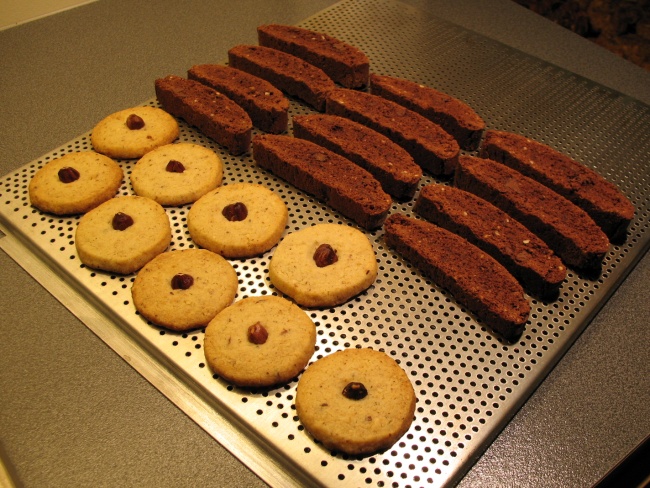
Chewy trail cookies and chocolate chip cookies
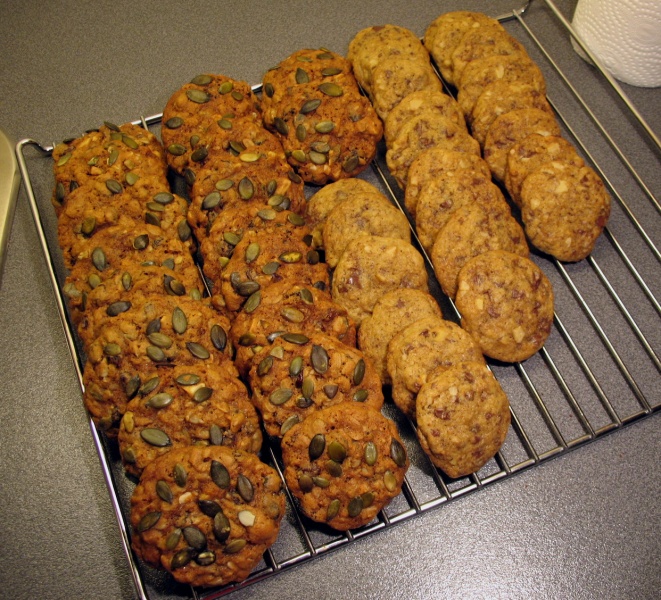


Comments
Your bread looks as good as storbought.. but with far superior taste!!.. would you suggest steaming the oven 2 minutes before loading the dough in? and then steaming while loading? So that steam is already there when the dough goes in??
Mebake
Hi Mebake,
Well, many folks recommend pre-steaming the oven. I've tried it myself on occasion, but I haven't really noticed much difference to tell you the truth. Most of the steam escapes the oven when you're loading the loaves anyway... right?
But try both, and see what gives you the best results!
Hans,
You're a talented baker. I have a question: you said you bought stones on the way home. If I wanted to try what you did, are these special stones that you buy at a baking store? (Sorry, I have not yet tried sourdough bread, etc, so I'm a complete dunderhead). And do you put them inside the oven while it's preheating, throwing water when?
Could you do a step-by-step for me, please?
Thanks mucho.
Hi,
And thanks! :)
I didn't buy them, I found them next to the sidewalk on my way back home! :)
And yes, I put the bread pan on the oven floor when I start pre-heating the oven. When the loaves are ready to be baked, I boil 3/4 cup of water. Load the loaves onto the stone, and then throw hot water onto the stones that are in the pan. Close the oven door as soon as you can, and leave the pan in there the first 10 - 13 minutes.
Hope that answers your questions!
until we go to the sauna and the store shelves are ravaged... : ) Hans, your loaves turned out Gorgeous. I like your bread pan idea...but I don't know where to find some of those nice smooth river stones, I'll have to search..the ones I have from the store for my plants I think have a bit of some sort of coating on them to make them shiny..I've noticed it shows up and comes off when they sit in water for a time..so I wouldn't recomment them from the store.
Sylvia
looking crumb.....the 5 grain is one of my favorites...
Judd
I get that gold colored crust when I bake loaves covered for the first 15 minutes. I wonder if the intense steam, condensing on the loaf, actually cools the surface and prevents or delays the Maillard (sp?) effect.
David
Hi David,
And thanks! :)
I think you're absolutely right about the effect of steam. Hamelman discusses this in some detail on pages 26-27 in his book. Steam enhances the crust colour, because, as you say, it keeps the surface cooler for a longer time compared to a bake with no steam. The cooler surface temperature promotes a longer period of enzymatic activity on the surface, resulting in more simple sugars that contribute to the crust colour. Moisture also increases the surface sheen, as discussed by Hamelman.
When you bake loaves covered, David, do you add any steam to the oven at all? Have you observed any differences related to oven spring when you bake them covered or not?
Hi, hansjoakim.
If I cover the loaf, I do not also steam the oven.
I can't say I see a difference in oven spring when I bake covered versus baking with steaming. I have the impression I get more bloom with covered loaves and, as you said, shinier crust. On the other hand, I also have more trouble getting an ear to form in covered loaves than when I steam the oven. I'm wondering whether I need to somehow adjust my scoring technique on loaves I'm going to bake covered.
If you have opinions on any of these questions, I'd like to hear them.
David
I can't remember where I read it..but doesn't the type of pre-ferment or flours..not sure but I know I read it one of my breadbooks.. used affect the crust color making it either a golden or reddish color?
Sylvia
Hi, Sylvia.
The only thing I can recall is that cold retardation makes for a reddish crust.
David
I have been trying to recall where I read this for the longest time. Now it's really gonna bug me : /
Hi Sylvia,
I can't recall reading anything about the type of preferment affecting crust colouration... Really, the only that comes to my mind, is that a flour with low enzymatic activity (a high falling number, I guess), will produce loaves with rather pale surface colour. It's vital to have sufficient enzymatic activity on the loaf surface in order to create enough simple sugars during the bake. Malt extract can be used to boost performance of these flours...
Hmm... you're not thinking about regular whole-wheat flour (rather reddish in colour) vs. white whole-wheat (more golden)? I've never tried white whole-wheat (it's most popular in the US and Australia I think), so I'm not sure if it would generate a different crust colour compared to regular WW.
I'm pretty sure it wasn't about anything you listed. If I recall, which my memory fails me a lot, I have been looking for this 'one little sentence' saying that a poolish gives a golden crust while a liquid levain gives a darker or redder crust..or the other way around, something like that and I have been looking ever since..the one thing I remember was the words 'a golden crust color' ... now I'll feel like I'm looking for the 'Golden Egg' ; ) It will probably turn out to be something I miss read, but I'am sure I will recognize this sentence when I read it again. : /
thank you hans, and oh yes, you answered my questions!
by the way, i looked at those stones again. if you say you picked them up from the street, you must live in some magic-filled, gated paradise. i certainly don't see those kinds of stones on my sidewalk!
your bread looks just wonderful. I use a cast iron pan in my oven and fill it with lava stones / the one you get in the nursery for plants. I noticed the crust of my bread getting a different color than before when I only used water in the pan (without the stones).
Beautiful loaves hansjoakim. I sometimes do covered baking and am working on a way to be able to use the entire surface of the stone while covered. As far as steaming, I have a small steam until that I use to spay 10-20 seconds of live hot steam into the cover. Either way, I do like covered because you don't have to drive moisture up into the controls. I haven't had any trouble but plenty have reported electronic control issues. With the cover you eliminate all that.
Anyway, I like your new flour and steam combo-Bravo!
Eric
Ah ha! I did! Everything's gorgeous as usual, Hans.
I am curious if there's much difference in steam creation between pretty rocks (like you have) and the porous volcanic rock I use.
I have pounds of old rusty screws, nails, bolts and nuts from my dad's workbench and have thought of tossing those in a pan one of these days.
I have four iron wedges that i have used to split wood along with a length of chain..keeps the heat real good...
judd
Lovely batches of wholesome looking cookies. You baked them up so lovely!
Sylvia
Thanks Lindy, Judd and Sylvia :)
Lindy: Do you use those porous lava rocks for steam? I'm not sure in what way those would differ from the ones I used... I guess the most important thing is to have something with large thermal mass/heat capacity. Stuff from your Dad's workbench would work great too!
Yes, Hans, I use the volcanic rocks. They're pretty lightweight compared to the rocks we find here in the soil or on the beaches.
Of course, all local stones are now covered with plenty of snow so unless St. Nick deposits some in my stocking, I'm out of luck for the next four or five months.
I think I'll switch out the volcanic rocks with nuts, bolts, and other hunks of metal just to see if it creates more thermal mass. Plus, it's a good excuse to clean out the tool cupboard.
Yes, weight is essential. The heat energy absorbed by the rocks as you preheat the oven is given by: rock mass x rock specific heat capacity x rock temperature increase during preheating.
If you're not blessed with heavy stones for christmas, you could try the nut & bolt thing. Try to find the largest, heaviest stuff you got lying around and stack it unevenly in a pan.
I baked two more levains yesterday, and it seems to me that a 3/4 cup of boiling water is perfect for my setup. Much more, and I'm afraid droplets of water will start to collect on the loaf surface, and one might end up with a rather "artificial" looking sheen to the crust.
Keep me posted, Lindy :)
under high oven heat?
Sylvia
I don't think that should be an issue.
I've been thinking about your question regarding preferment/levain and crust colouration, but I don't see any direct reason for a difference. Perhaps it has something to do with the amount of residual sugars available for caramelisation that is different for the two? We know that the pH is usually lower in levain doughs, and they are often fermented for longer... hmm.
and maybe it was something like just adding barley malt syrup..I could really make myself crazy here and yet I don't know till I find that sentence again. It will probably be something I misread and that's why I have been thinking about it for so long. I need to know just exactly what was written.
when heated, baking stones as well. So it is important that any stones from a river or lake are thoroughly dried first. This could take weeks depending on the size and humidity. Rush even a sauna rock and it will crack. Be very careful. I like to reduce hazzards whenever I can. Even in the sauna, I turn my face away from the rocks when splashing or pouring water over them. There are sauna stone web sites that can instruct you as to which stones to choose but remember, you choose them at your own risk.
If you remove the pan in 15 minutes or so after steaming the oven, it is not so important that the stones hold the heat. Boiling water is poured onto a hot pan and continues to boil the first 10-15 minutes. The water will boil without stones too, but lava stones will not explode and reduce water splashing as it boils.
Sauna stones are used differently, the water runs over and thru the stones and the water should not pool on them nor should the stones stand in water. This increases risk of cracking or exploding. Risk from splashing as the water boils is not reduced. To me, this method of solid rocks in a hot pan is too risky.
Mini
I never really planned on using the rocks. Thanks for the explanation. I'll stick with lava stones.
Sylvia
If it's weight I'm after, that's easy. Out of curiosity, I placed the pan containing the lava rocks on my scale: it weighs 2739 grams.
My old wood splitting wedge weighs 3124 grams by itself.
I just moved two boules of Hamelman's sourdough into the fridge for overnight retarding, so I'll find more hunks of metal to add to the pan and try it tomorrow.
Thanks, Hans. Will let you know how it works out.
Sounds great!
Just be careful when you pour hot water on those hunks; wear long sleeves and keep your face at a distance so you're not hit by an intense burst of steam.
What biscotti recipe did you use?
Hi ryeaskrye,
And thanks :)
It's the double chocolate biscotti recipe from Suas' book. Do you have that one?
Word of caution...I am sure the water is going to react differently on the hot iron than it does on the porous lava lock...stand back...please
Judd
I just updated my FireFox and now I can see them. Merry Holidays!
Mini
Thanks for the caution, Judd. I heat my house with wood and when steaming the oven, use either my leather woodstove gloves or my OveGlove (and a piece of cardboard over my oven glass).
I had been using half a cup of boiling water but that boiled down very quickly, so I plan to increase it to 3/4 cup.
I noticed when I steamed the oven using the 3/4 cup of boiling water, it had boiled down within a few minutes. I'm using the bottom of a broiler pan to hold the water and hunks of metal and a few lava rocks.
Is there an average time to aim for before the water evaporates?
Wow, that's quick!
Hmm. For most loaves, I'd say you want to aim at baking the first 10 - 15 mins. with steam. That is, you want to have generous amounts of steam filling the oven for roughly the first third of the bake.
How did the surface of the loaf look after all water evaporated? Did it seem moist and shiny from steam in the oven, or did it appear to be dryer? Do you notice any steam escaping the oven while you bake?
I don't think rapid evaporation should be a problem as long as most of the steam is trapped inside the oven for the prescribed amount of time.
I'm afraid that if you increase the water amount in the beginning, moisture on the loaf surface will collect in small water droplets and start running off the loaf. That amount of steam would result in an artificial, non-attractive shine to it.
You could alternatively steam twice; Hamelman discusses this briefly in the introductory text to his levain chapter!
How did the loaves turn out, by the way?
There's no sheen at all to the crust, Hans.
I now realize that using lava rocks is deceptive because you can't see the water level compared to when there are metal hunks in the pan and the pan bottom is exposed. So there's no way to tell how fast it evaporates.
Once I realized how fast that water dissipated at the start of the bake, I did add about a cup more. I've often wondered why my scores don't fully develop as much as I'd like. Maybe inadequate steaming is part of the cause.
I've re-read Hamelman on steaming and he advises to steam the oven three times when baking naturally leavened breads: prior to loading the bread, upon loading the bread, and the final time within a couple of minutes of the last steaming.
I had added a few ice cubes to humidify the oven (which is natural gas) before loading but don't think it made that much difference. I've no idea how to block the vents as there's a strip of vents behind the oven door handle and perhaps more at the top of the stove (can't really tell - will have to dig out the manual).
I've pictured one boule below - I left them in the full 40 minutes but no longer as I was getting concerned about the crust becoming too dark (these are gift boules). After handling them a bit, I now wonder if I should have left them in a bit longer given I had to open the oven door a couple of times.
No idea what the crumb looks like because I won't see or taste it. I just hope the recipients like it.
I mixed Susan of San Diego's little boule formula and will bake that tomorrow with triple steaming and see if that makes any difference.
Thanks for all the help...and my apologies for hijacking your blog.
Thanks for the photo and report, Lindy :)
No doubt, that's an impressive oven spring and a lovely, open cut! Is it any different from your usual results?
As you write, I'm not sure if pre-steaming the oven has any effect at all since most of it escapes when you load the breads anyway. If anything, it might just lower the oven temperature unnecessary.
Well, your observations made me curious, so I had a look in my storage space, and dug out some unused hardware. I replaced the rocks with approx. 1.5 kg of chains and bolts and put them in the bread pan. This seems to be markedly less than the amount you used, Lindy, is that right? I was happy with the steam effect of the rocks, and those weighed in at roughly 1.5 kg, so I didn't want to offset that variable too much. Here's what I ended up with:
I'm travelling home for christmas later today, and I'm bringing along two loaves that I'll split with my sister (she's crazy about multigrain breads and I can't live without my pain au levain, so this was a reprise bake of the two loaves in the original post above). I filled the pan with just shy of a cup of boiling water and left it in the oven a full 15 mins. When I hauled the pan out there was still some water at the bottom of the pan; actually more or less what remained when I previously used the rocks. Here are the loaves:
They turned out very similar to those in the original post, but perhaps with slightly less sheen to the crust. It seemed like more moisture was collecting on the surface during the steaming period when I used rocks, but I can't tell for sure...
These loaves were'nt fully sprung until about 16-17 mins. into the bake (they came straight from the fridge), so I think it's worth spending some time to optimise the steaming technique for your oven.
Nice assortment of metal, Hans. Your last two loaves are as beautiful as your first two. Is your oven electric?
I tried the triple steaming today, adding a cup of water a few minutes before loading the bread. As I had been baking bagels, the oven and pan were quite hot and that cup evaporated quickly. After loading the little boule, I added two cups of boiling water, followed by another cup a few minutes later. It took about 15 minutes for the water to boil off, so at least the oven is staying humidified longer with the additional water.
The bread had good oven spring and the cut opened, but not as nicely as yesterday's. Not sure if that was because of the steam or because of a couple of shortcuts I had to take with the dough because of time constraints. The crust had no shine.
I'll be baking Hamelman's light rye later (more gifts) and will eliminate that third steaming.
Appreciate your help - at least I'm making some progress in determining the amount of water to use.
Hans i didn't notice if she was using an electric or gas oven...I made a plug for the vent on my electric oven...when the time is up...usually when i turn the breads at 20 min....i pull the plug and wait...
thanks for the suggestion on your earlier post...it is snowing here and went out in between my semolina loaves rising...to get some dutch chocolate for some biscotti with hazelnuts and cranberries....the power of suggestion...looks like will have to shovel some snow soon!
Cheers...
Judd
For anyone pondering how to better steam the oven, please never block the vents on a gas oven. The vents are there to maintain proper oxygen for the combustion. Gas ovens make moisture in the combustion process of burning gas so it's already more humid in the oven.
My take on gas and steaming has been that you are better off not steaming and using a covered method instead. If you cover the loaf with a SS pan that traps the steam created when the dough hits the stone, the effect is the same. Look at Susans boules and see the spring she gets from covered baking for the first 13-15 minutes. She isn't steaming at all.
Eric
I figure if I take care of my stove, it will take care of me, but in my case, blocking the top oven vent has no effect on oxygen for combustion - per my stove manual.
Now, if I blocked the vents on the oven bottom, or covered an entire rack with foil or some other substance, the manual has a warning in big black block letters that carbon monoxide poisoning could occur.
I'm writing this response simply because I think we all need to read the operating instructions that come with our stove, especially if anyone is thinking of using a baking stone that might be the same size as the rack it sits on and has vents on the oven floor.